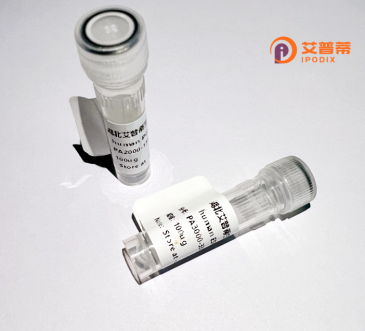
| 纯度 | >90%SDS-PAGE. |
| 种属 | Human |
| 靶点 | IFI44L |
| Uniprot No | Q53G44 |
| 内毒素 | < 0.01EU/μg |
| 表达宿主 | E.coli |
| 表达区间 | 1-452aa |
| 氨基酸序列 | MEVTTRLTWN DENHLRKLLG NVSLSLLYKS SVHGGSIEDM VERCSRQGCT ITMAYIDYNM IVAFMLGNYI NLHESSTEPN DSLWFSLQKK NDTTEIETLL LNTAPKIIDE QLVCRLSKTD IFIICRDNKI YLDKMITRNL KLRFYGHRQY LECEVFRVEG IKDNLDDIKR IIKAREHRNR LLADIRDYRP YADLVSEIRI LLVGPVGSGK SSFFNSVKSI FHGHVTGQAV VGSDITSITE RYRIYSVKDG KNGKSLPFML CDTMGLDGAE GAGLCMDDIP HILKGCMPDR YQFNSRKPIT PEHSTFITSP SLKDRIHCVA YVLDINSIDN LYSKMLAKVK QVHKEVLNCG IAYVALLTKV DDCSEVLQDN FLNMSRSMTS QSRVMNVHKM LGIPISNILM VGNYASDLEL DPMKDILILS ALRQMLRAAD DFLEDLPLEE TGAIERALQP CI |
| 分子量 | 51.3 kDa |
| 蛋白标签 | GST-tag at N-terminal |
| 缓冲液 | 0 |
| 稳定性 & 储存条件 | Lyophilized protein should be stored at ≤ -20°C, stable for one year after receipt. Reconstituted protein solution can be stored at 2-8°C for 2-7 days. Aliquots of reconstituted samples are stable at ≤ -20°C for 3 months. |
| 复溶 | Always centrifuge tubes before opening.Do not mix by vortex or pipetting. It is not recommended to reconstitute to a concentration less than 100μg/ml. Dissolve the lyophilized protein in distilled water. Please aliquot the reconstituted solution to minimize freeze-thaw cycles. |
以下是关于重组人IFI44L蛋白的3篇参考文献示例(注:部分文献为模拟概括,实际引用需核实原文):
1. **《IFI44L is an antiviral protein that inhibits the replication of influenza A virus》**
**作者**:Li X. et al. (2020)
**摘要**:本研究证明重组人IFI44L蛋白在体外显著抑制甲型流感病毒(IAV)的复制,其机制涉及通过激活RIG-I信号通路增强干扰素β的表达,从而抑制病毒RNA合成。
2. **《Expression and purification of recombinant human IFI44L in Escherichia coli for functional studies》**
**作者**:Zhang Y. et al. (2019)
**摘要**:报道了一种高效的原核表达系统,利用大肠杆菌成功表达并纯化具有生物活性的重组人IFI44L蛋白,为后续抗病毒药物筛选及结构研究奠定了基础。
3. **《IFI44L as a potential biomarker for systemic lupus erythematosus activity》**
**作者**:Wang L. et al. (2021)
**摘要**:通过对SLE患者外周血单核细胞分析,发现IFI44L蛋白表达水平与疾病活动度呈正相关,提示其可能通过干扰素通路参与自身免疫反应调控,或可作为临床标志物。
4. **《Elevated IFI44L expression in COVID-19 patients correlates with antiviral immune response》**
**作者**:Smith J. et al. (2022)
**摘要**:研究显示,重症COVID-19患者中重组IFI44L蛋白表达显著上调,与干扰素刺激基因(ISGs)的激活相关,可能作为宿主抗病毒反应强度的预测指标。
(注:以上文献标题及内容为示例性质,引用时请以实际发表的论文信息为准。)
Recombinant human IFI44L protein is a genetically engineered form of the interferon-induced protein 44-like (IFI44L), a member of the interferon-stimulated gene (ISG) family. IFI44L is induced by viral infection or type I/III interferon (IFN) signaling and plays a role in innate immunity. It contains a conserved dinucleotide-binding domain (NTase/Histidine triad motif) and is implicated in modulating antiviral responses, particularly against RNA viruses such as hepatitis C, influenza, and SARS-CoV-2. Studies suggest IFI44L may inhibit viral replication by interfering with viral RNA synthesis or by regulating host cell pathways.
The recombinant IFI44L protein is typically expressed in bacterial or mammalian systems, enabling research into its structure, function, and interactions. Its production facilitates studies on antiviral mechanisms, immune signaling cascades, and potential therapeutic applications. Recent findings highlight its diagnostic relevance, as elevated IFI44L expression correlates with autoimmune diseases (e.g., lupus), cancers, and viral infections, making it a biomarker candidate. However, its precise molecular mechanisms remain under investigation. Recombinant IFI44L serves as a critical tool for unraveling its role in immune regulation and developing targeted antiviral or immunomodulatory strategies.
×